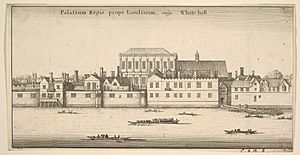Wedding of Princess Elizabeth and Frederick V of the Palatinate facts for kids
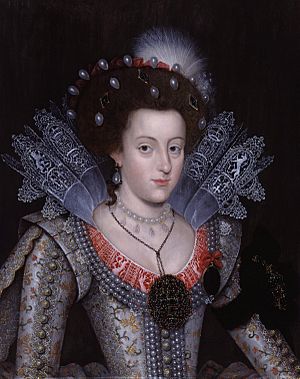
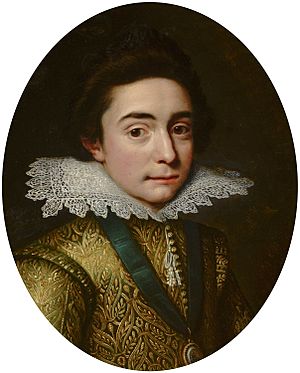

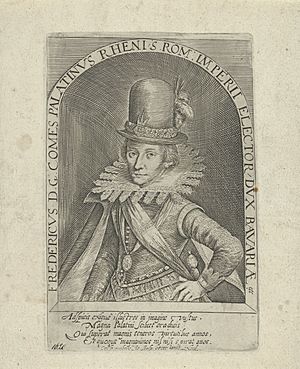
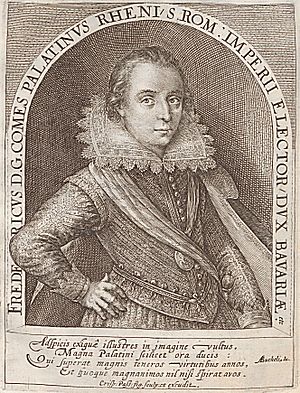
In February 1613, a big wedding took place in London. It was for Elizabeth Stuart (1596–1662), who was the daughter of King James VI and I. She married Frederick V of the Palatinate (1596–1632). The celebrations were huge! There were fireworks, special plays called masques, exciting tournaments, and even a pretend sea battle. A new "Marriage Room" was built next to the Banqueting House at Whitehall Palace just for the event. People wrote many letters and pamphlets describing all the fun.
Contents
Frederick Arrives in London
Frederick arrived in England on October 16, 1612, at Gravesend. He traveled by river to Whitehall Palace in London. There, he met Prince Charles, who was then called the Duke of York. Frederick then met King James in the new Banqueting Hall. They spoke in French because Elizabeth didn't speak much German, and Frederick didn't speak much English. Frederick showed his respect by kissing the hem of Elizabeth's dress. The King gave him a ring and he stayed at Essex House.
Many people thought Elizabeth's mother, Anne of Denmark, wasn't happy about the marriage at first. She felt Elizabeth was marrying someone not royal enough. But after meeting Frederick, she was "much pleased with him." People said Frederick didn't like tennis or riding much. He preferred talking with Princess Elizabeth.
Elizabeth's clothes were updated for the wedding. She got new silks, satins, and gold lace. Her "bodies" (a type of corset) and farthingales (hoop skirts) were also new. The Venetian ambassador said these new clothes made her look even more beautiful.
Sad News: Prince Henry Dies
Sadly, Prince Henry, who was next in line to the throne, died from a fever on November 6, 1612. This sad event changed the wedding plans. Some people thought Elizabeth should not get married and leave England. There were even rumors that some Scottish courtiers wanted her to marry the Marquess of Hamilton instead. This would have kept the royal families of England and Scotland closer.
King James talked with his advisors about it. They decided to move the wedding dates forward. An engagement ceremony was set for January 6, and the main wedding for February 14. Henry's death also changed the entertainment plans. Many of the original ideas for the masques were changed or canceled.
Frederick spent time with King James in the countryside. Elizabeth even got one of her late brother's nightgowns. King James often played cards with Elizabeth at Whitehall.
January 1613: Engagement and Gifts
The marriage contract was finished. On December 27, Frederick and Elizabeth had an engagement ceremony at Whitehall. Frederick took Elizabeth's hand and led her to the King. They knelt on a special carpet and received blessings from the King and the Archbishop of Canterbury.
Frederick wore purple velvet with gold. Elizabeth wore black satin with silver lace, a black cloak, and white feathers in her hair. White feathers quickly became very popular in London fashion. Elizabeth's mother, Queen Anne, was not there because she was sick. After the ceremony, Frederick and Prince Charles went back to wearing mourning clothes.
King James ordered everyone at court to wear their best clothes for the wedding day. He did not want them to wear mourning clothes for Henry.
Frederick gave New Year's Day gifts to the women in Elizabeth's household. He gave Elizabeth two very expensive diamond pendants and two beautiful pearls for earrings. She wore them in the days that followed. He also gave jewels to Queen Anne's ladies. King James told Frederick not to spend too much on gifts for everyone.
Frederick ordered more gifts from Paris, including jewel boxes and a special coach for Elizabeth. This coach was covered inside and out with embroidered velvet. Even the Queen of France visited the workshop to see it! On February 7, Frederick became a knight of the Order of Garter at Windsor Castle. Elizabeth went to stay at St James' Palace. Both Elizabeth and Frederick were sixteen years old when they got married.
Edinburgh's Special Gift
The city of Edinburgh sent a gift of 10,000 merks (an old coin) to Elizabeth. This was a promise made at her baptism in 1596. James Nisbet brought the money to London. He gave her a diamond necklace on the wedding day and the money three days later.
Nisbet bought a new suit of clothes in Edinburgh and hired a horse. When he got to London, he had a new cloak made. He went to court to meet John Murray, who worked for the King. The King told Nisbet to buy a very valuable diamond necklace for Elizabeth. She would receive it on the morning of the wedding.
Nisbet's old clothes were not fashionable in London. So, he ordered new clothes like John Murray's. A Scottish merchant helped him. He got a velvet suit, a castor hat, and a satin collar.
Nisbet watched the fireworks from the Savoy. He bought the necklace for Elizabeth, which cost £815. He also paid to get a good spot to watch the wedding procession. He saw a "masquerade" (a type of party). Elizabeth later sent a thank-you letter to the leader of Edinburgh, who was James Nisbet's father-in-law.
The Lord Mayor of London and other city leaders gave Elizabeth a pearl necklace worth £2000.
Fireworks and Sea Battles
The fireworks show on February 11 was amazing! It was put on by royal gunners. The show was based on a story from a famous poem called The Faerie Queen. Most of the displays were on barges (flat boats) on the Thames. There was also a "fort and haven" built on land for the sea battle. Everyone could see it from Whitehall Palace.
A poet named John Taylor wrote about the "Fire and Water Triumphs." The fireworks told a story about Lady Lucida, a queen, who was captured by a magician. Saint George came to rescue her. Fiery balls shot into the air, and "artificial men" spit flames. The magician's pavilion went up in flames! Saint George fought a dragon and a giant.
Then there was another firework display. It showed three ships attacking the "Castle of Envy" on an island. The castle was said to be built on a mound of snakes and scorpions, all shooting fire. One person said the fireworks were "reasonably well performed," but the last castle of fire was a bit of a disappointment.
Pretend Sea Battle on the Thames
A pretend sea battle took place on February 13. It was between Lambeth and Temple stairs on the Thames. King James, Queen Anne, and the royal family watched from Whitehall.
The show was a battle between Christian and Turkish ships. There was a Turkish harbor and castle built on land. The castle had 22 cannons! A Turkish watchtower was set on fire. After the English ships won, "captives" in Turkish costumes were brought to Whitehall.
Some people thought the battle was like the famous Battle of Lepanto or the defeat of the Spanish Armada. However, one observer thought it didn't meet expectations. King James and the royals didn't seem to enjoy just the shooting of guns. Some soldiers and sailors were even hurt. Because of this, plans for a second day of the battle were canceled.
The Wedding at Whitehall
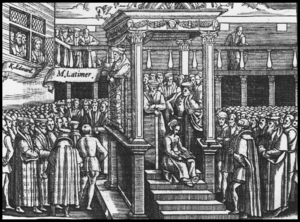

The wedding happened on Sunday, February 14, 1613, in the chapel of Whitehall Palace. The chapel was decorated with beautiful tapestries showing stories from the Bible. These tapestries had been bought by Henry VIII many years before.
A special path was made around the palace so more people could see the wedding party. A raised walkway crossed an open courtyard. King James walked from his private rooms to the chapel. Frederick walked from the Banqueting Hall, and then Elizabeth followed.
One person who watched, John Chamberlain, saw the procession from a window. He said King James was dressed "somewhat strangely." He also noticed that the daughters of two important noblemen were very well dressed. This showed their loyalty, even though the groom was a Protestant prince.
Elizabeth wore a special crown with diamonds and pearls. Her long, amber hair was down to her waist, decorated with gold and jewels. Her white gown was richly embroidered. About 14 to 16 ladies, dressed in white satin, held her long train.
The Venetian ambassador noted that Elizabeth wore a diamond necklace, probably the one from Edinburgh. Queen Anne, Elizabeth's mother, wore white satin and was covered in pearls and diamonds. Her jewels were thought to be worth an amazing £400,000! The wedding of Elizabeth and Frederick cost a huge amount of money, about £93,293 in total.
The Archbishop of Canterbury led the ceremony. Elizabeth was a bit nervous and couldn't help laughing. After the wedding, guests drank spiced wine. Dinner was served in the new room, which was decorated with tapestries showing the defeat of the Spanish Armada.
The poet John Donne wrote a special poem for the wedding, celebrating Elizabeth and Frederick as two phoenixes becoming one. People saw Elizabeth and Frederick as important Protestant leaders in Europe. Many poems and plays at the wedding reception talked about this. They celebrated the marriage as a victory against Catholic influence.
Three Masques at Whitehall
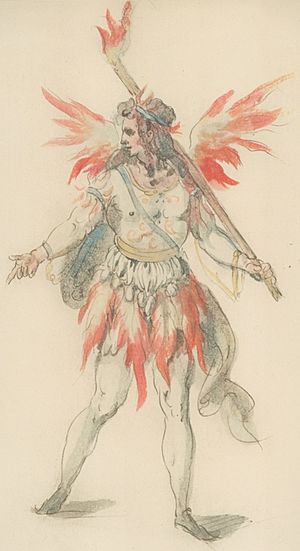
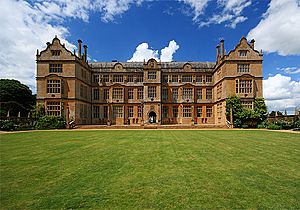
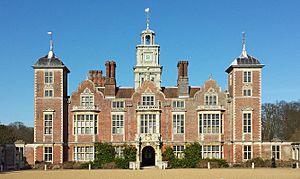
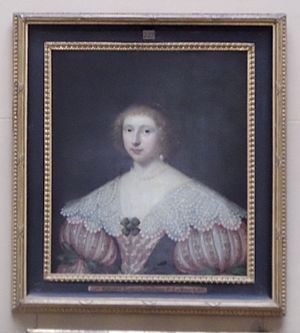
Stars and Statues: The Lord's Masque
After the wedding, on February 14, a masque by Thomas Campion was performed. It was called The Masque of Lords and Honourable Maids. The stage showed a forest scene. Then, eight performers dressed as stars came down on moving clouds. These clouds were designed by Inigo Jones.
Sixteen fiery pages with torches danced below. As the "stars" came down, the forest scene changed. It showed four silver women who were statues. They came to life and danced! Then, four more women appeared and came to life. The performers danced with the bride and groom. The scene then changed to show golden statues of Elizabeth and Frederick. A special needle-like monument gave a message in Latin, saying Elizabeth would have a great future.
People had different opinions about the show. One ambassador thought it was beautiful and was impressed by the moving stars. Another person heard it wasn't "great."
Other masques were also performed. One was by George Chapman and another by Francis Beaumont. These were put on by groups of lawyers in London. People were not allowed to wear hoop skirts to these events to save space!
Tournament: Running at the Ring
On Monday, February 15, there was a tournament at Whitehall. This was a competition where riders tried to lift a hoop with a spear. Queen Anne, Elizabeth, and other noblewomen watched. King James rode first. Prince Charles did very well. The skilled riders were praised for their performances.
Stories of New Lands in a Masque
Chapman's masque was performed on February 15. The performers arrived in a procession. King James made them go around the tilt yard so everyone could see them. This masque was about people from Virginia and gold mining from Guiana.
The musicians were dressed as "Virginean priests" with feather hoods and turbans. The main performers were dressed as "Indian habits" or "Virginian Princes." They wore olive-colored masks and had long, black hair. Each horse had two "Moores," or African servants, dressed as Indian slaves. One observer said there were 100 Africans dressed in blue and gold.
The stage had a rock with gold veins. A god of wealth spoke, and the rock opened to show a gold mine. Then, a group of baboons danced. The masque suggested that people from Virginia should become Christian before their land's wealth was taken. King James loved the show and praised the lawyers who put it on.
Olympic Knights
Another masque, by Francis Beaumont, was also performed. The performers came to the palace by river. The show was about the Olympic Games, celebrating the marriage of the Thames and Rhine rivers. Statues made of gold and silver came to life. Then, a country dance with servants and baboons was shown. Finally, fifteen "Olympian knights" appeared, danced, and invited ladies from the audience to dance with them.
On February 21, there was a big dinner in a new dining room. The Lords who didn't do well in the tournament paid for it. King James left London on February 22. Queen Anne went to Greenwich Palace a few days later. Charles and Frederick went to Cambridge.
Elizabeth had planned a masque with her fifteen maidens, but it was likely canceled after Prince Henry's death.
Leaving England
There was some talk about how much money was being spent on Frederick's visit. On February 24, Queen Anne, Frederick, and Elizabeth attended a christening. The next day, the fancy coach Frederick ordered from Paris arrived.
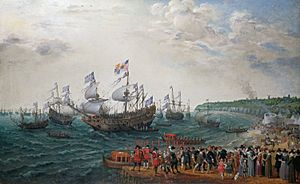
On April 10, Queen Anne and Elizabeth traveled to Greenwich and then to Rochester. The trip was delayed. Elizabeth and Frederick finally sailed from Margate on April 26. They left on a ship called The Prince Royal. Elizabeth was joined by several important ladies. Other English ships and five merchant ships also sailed with them.
Elizabeth's household in Germany was supposed to have 49 people, but she took many more. The whole group numbered 675 people! Her jeweller also went with her. Elizabeth had bought many jewels and had to ask for the bills to be paid. She said it was important for her to leave gifts for her friends when she left her home country.
Soon after Elizabeth left, Queen Anne went to Bath. In June, she saw another pretend battle with a Turkish ship in Bristol.
In May, a theater manager was paid for putting on many plays for Elizabeth, Frederick, and Charles at Whitehall. These plays included Much Ado About Nothing, The Tempest, and The Winter's Tale.
Journey to Heidelberg
The ships arrived in Ostend on April 27, 1613. Other princes joined them. Elizabeth and Frederick were rowed ashore the next day. Several of Elizabeth's female attendants were listed as joining her on the journey.
Vlissingen and Middelburg
Plans for the royal party's arrival in Vlissingen and Middelburg were made. One official was disappointed because he didn't receive a gift from Elizabeth.
The Hague
Frederick went ahead to The Hague. Elizabeth went to Middelburg, then other towns, and rejoined Frederick at The Hague. On May 8, Frederick left for Heidelberg. Elizabeth received gifts from the Dutch government, including jewelry, furniture, and tapestries.
Elizabeth then visited other cities like Leiden and Haarlem. In Haarlem, the city gave her a cradle and baby clothes. In Amsterdam, she was welcomed and given gold plates. She then traveled to Utrecht, Rhenen, and Arnhem. On May 20, she reached Emmerich am Rhein and then went to Düsseldorf, Cologne, and Bonn. A report of her journey mentioned the seven hills of the Siebengebirge and a legend about the Devil walking in a castle there.
Journey on the Rhine River
After a picnic, Elizabeth boarded a luxurious boat on the Rhine. Frederick joined her at Bacharach. They arrived in the Palatinate on June 3. Here, Elizabeth had to give gifts to her companions who were returning to England. She bought jewels on credit for this.
At Oppenheim, they took carriages to Frankenthal. There was a special welcome ceremony there. Townspeople dressed as "Turks, Poles, & Switzers." At night, there was a candlelit show about Solomon and the Queen of Sheba. The next night's show was about the Siege of Troy. Frederick rode ahead to Heidelberg to welcome his bride. Elizabeth arrived on June 7 for a week of grand celebrations.
On June 13, there was a tournament with "mad fellows with tubs set on their heads." The next day, many of Elizabeth's English companions left to return home.




